News
New Publication on High-speed testing of superconducting electronics
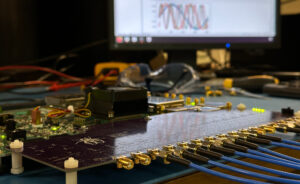
A new publication written by the group on custom sensing equipment was recently published in the Journal of Instrumentation.
Abstract
Novel electronic devices can often be operated in a plethora of ways, which makes testing circuits comprised of them difficult. Often, no single tool can simultaneously analyze the operating margins, maximum speed, and failure modes of a circuit, particularly when the intended behavior of subcomponents of the circuit is not standardized. This work demonstrates a cost-effective time-domain data acquisition system for electronic circuits that enables more intricate verification techniques than are practical with conventional experimental setups. We use high-speed digital-to-analog converters and real-time multi-gigasample-per-second waveform processing to push experimental circuits beyond their maximum operating speed. Our custom time-tagging data capture firmware reduces memory requirements and can be used to determine when errors occur. The firmware is combined with a thermal-noise-limited analog frontend with 50 dB of dynamic range. Compared to currently available commercial test equipment that is seven times more expensive, this data acquisition system was able to operate a superconducting shift register at a nearly three-times-higher clock frequency (200 MHz vs. 80 MHz).
New Publication: Photolithography-compatible three-terminal superconducting switch for driving CMOS loads
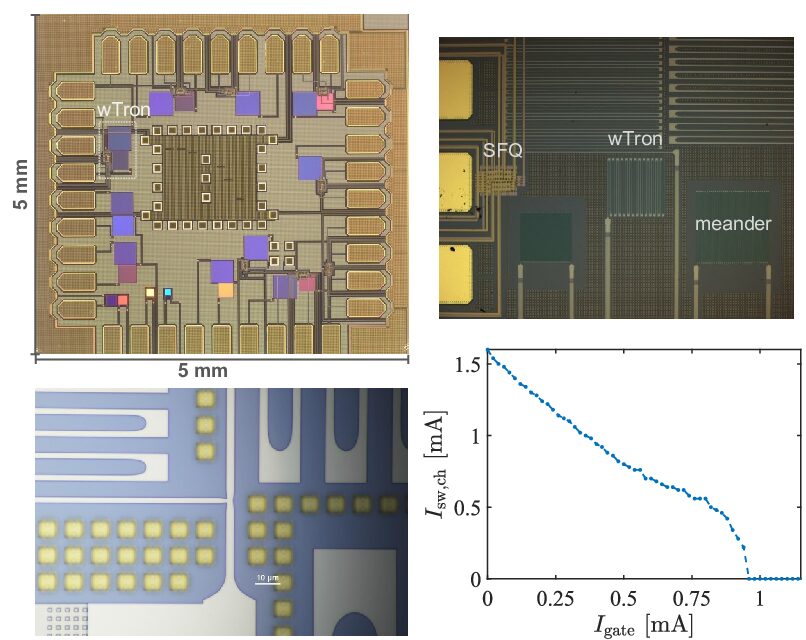
A new paper written by the group was recently published in Physical Review Applied.
Dip Joti Paul, Tony X. Zhou, Karl K. Berggren, “Photolithography-compatible three-terminal superconducting switch for driving CMOS loads,” Physical Review Applied, 24, 2, p. 024060, August 2025.
Abstract
Superconducting devices have enabled breakthrough performance in quantum sensing and ultralow-power computing. Nevertheless, the need for a cryoelectronics platform that can interface superconductor electronics with complementary metal-oxide-semiconductor (CMOS) devices has become increasingly evident in many cutting-edge applications. In this work, we present a three-terminal micrometer-wide superconducting-wire-based cryotron switch (wTron), fabricated using photolithography, that can directly interface with CMOS electronics. The wTron features an output impedance exceeding 1 kΩ and exhibits reduced sensitivity to ambient magnetic noise, similar to its nanoscale predecessor, the nanocryotron. In addition, its micrometer-wide wires support switching currents in the milliamp range, making it well suited to driving current-hungry resistive loads and highly capacitive CMOS loads. We demonstrate this capability by using the wTron to drive room-temperature CMOS electronics, including a light-emitting diode and a metal-oxide-semiconductor field-effect transistor (MOSFET) with a gate capacitance of 500 pF. We then examine the optimal design parameters required for wTrons to drive CMOS loads, such as MOSFETs, high-electron mobility transistors, and electro-optic modulators. Furthermore, to demonstrate the foundry readiness of the wTron, we fabricate wTrons using MIT Lincoln Laboratory’s SFQ5ee superconducting process and characterize their switching behavior. Our work shows that the wTron will facilitate the interface between superconductor electronics and CMOS devices, thereby paving the way for the development of foundry-compatible cryoelectronic ecosystems to advance next-generation computing and quantum applications.
Community Outreach Event: Appalachian Optics Outreach Event 2025
On July 14th, QNN group co-leader Dr. P. “Donnie” Keathley led a successful hands-on optics workshop for middle and high school teachers in Eastern Kentucky. This is hopefully the first of many outreach workshops in the coming years. With coordination from the local organization Kentucky Valley Educational Cooperative (KVEC), Dr. Keathley designed and led a workshop for teaching a sample optics curriculum for educators to take into and adapt for their classrooms.
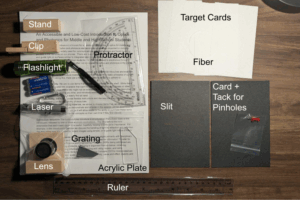
An example of a basic kit of materials used for all for the experiments.
In this one-day workshop for four educators, Dr. Keathley modeled a curriculum covering ray optics and waves, with hands-on experiments on imaging, fiber optics, and spectroscopy which involved low-cost and non-specialized materials. To the right is one of the experimental material kits given to the teachers. He taught them as if they were the students, handing out textbook-like material which included the how-to on the experiment. He also discussed how the curriculum could be used, including breaking points to simplify or extend the material.
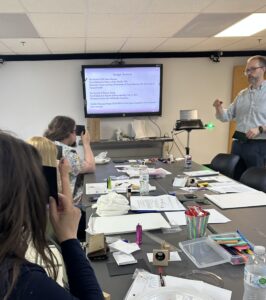
Teachers testing an experiment on the wave pattern of light using black index cards with two pin-holes while Dr. Keathley explains
As part of the proposal for his NSF CAREER award Dr. Keathley included an optics outreach effort in Eastern Kentucky. The NSF has a long-term interest in broadening the pool of future scientists. But as to why work with Eastern Kentucky in particular? The Appalachia region, including Eastern Kentucky, have historically low STEM engagement and opportunity. Additionally, when researching outreach efforts, Donnie found many more efforts targeting urban areas, and thus decided to take the opportunity to focus his outreach on more rural environments. He was able to connect with KVEC before submitting the proposal, and they were interested in working with him.
As a final draw to selecting this area, Dr. Keathley grew up in the region and recalls the relative sparsity of opportunities to engage with STEM compared to areas like the Boston metro area with large science museums, research universities, and STEM industry.
Throughout the year-long design process, KVEC’s input on community needs and connections to educators were crucial. While Dr. Keathley’s original idea focused on a hand-on optics workshop for the middle and high school students, KVEC’s experience helped reframe it to focus on teaching the teachers for a larger and more enduring impact. As Dr. Keathley notes, the impact of an outreach event can be “frustratingly nebulous and difficult to define rigorously.” However, by focusing on educators, the impact of one workshop can not only endure over multiple years but also touch hundreds of students. If each of the four teachers were able to incorporate even one new experiment and unit from the workshop, about 425 students would benefit in the first year alone. And the community outreach is not planned to end after this one event. KVEC and Donnie plan to follow up with these four teachers with a zoom call in December on how and if they have been able to incorporate it into their curriculum. Also, the initial planning for a second workshop next summer is already underway!
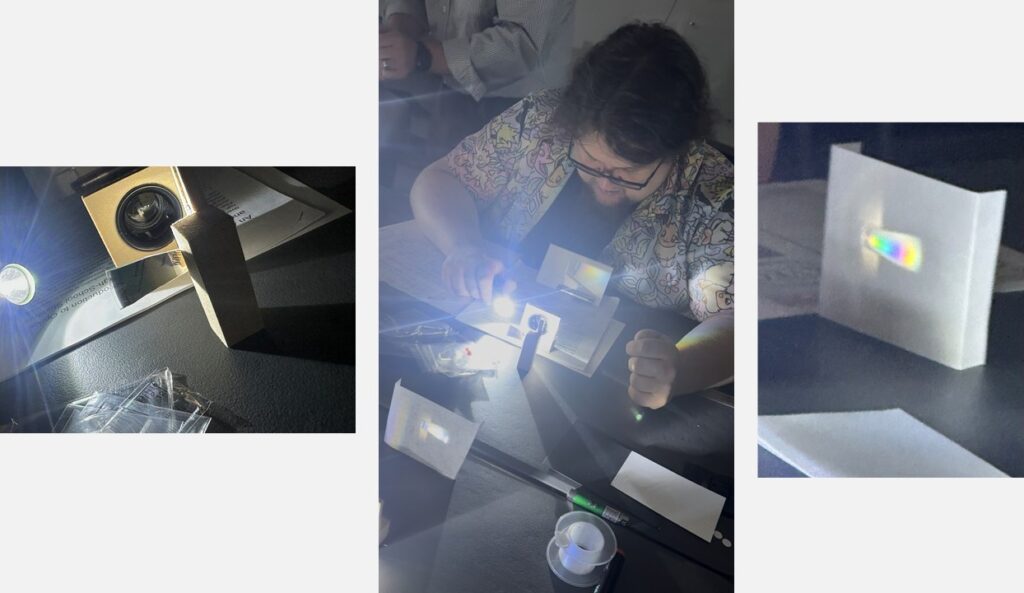
An educator at a workshop performing an experiment on making a camera image of a very clear example of a diffraction grating.
For additional photos from the event, visit KVEC’s flicker account.
New Publication: Determination of mid-infrared refractive indices of superconducting thin films using Fourier transform infrared spectroscopy
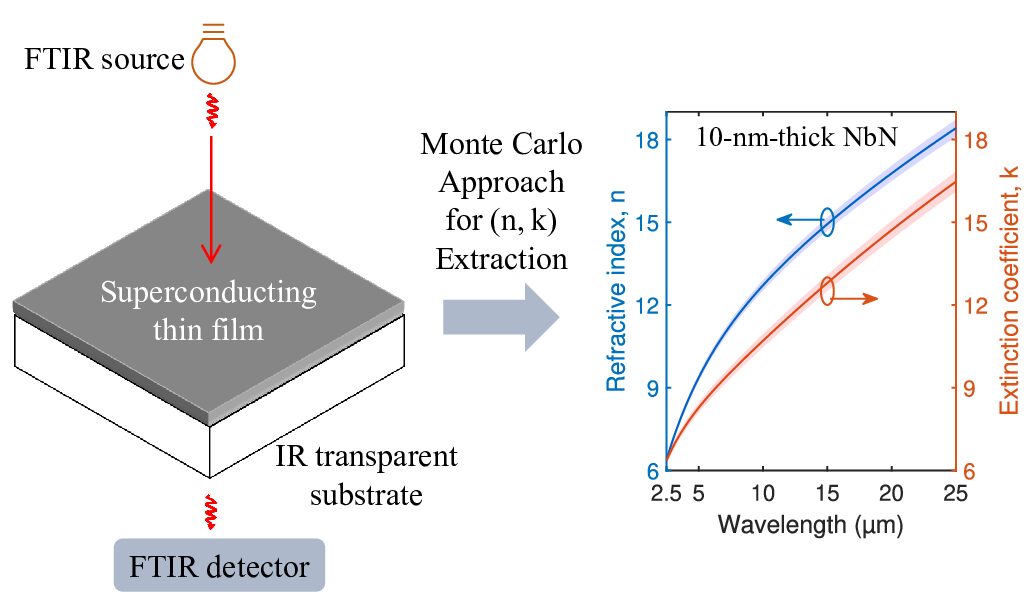
A new publication written by the group on was recently published in Applied Physics Letters.
Dip Joti Paul, Tony X. Zhou, and Karl K. Berggren, “Determination of mid-infrared refractive indices of superconducting thin films using Fourier transform infrared spectroscopy,” Appl. Phys. Lett., 126, 25, p. 252601, June 2025.
Abstract
In this work, we present a technique to determine the mid-infrared refractive indices of thin superconducting films using Fourier transform infrared spectroscopy (FTIR). In particular, we performed FTIR transmission and reflection measurements on 10-nm-thick NbN and 15-nm-thick MoSi films in the wavelength range of 2.5–25 μm, corresponding to frequencies of 12–120 THz or photon energies of 50–500 meV. To extract the mid-infrared refractive indices of these thin films, we used the Drude–Lorentz oscillator model to represent their dielectric functions and implemented an optimization algorithm to fit the oscillator parameters by minimizing the error between the measured and simulated FTIR spectra. We performed Monte Carlo simulations in the optimization routine to estimate error ranges in the extracted refractive indices resulting from multiple sources of measurement uncertainty. To evaluate the consistency of the extracted dielectric functions, we compared the refractive indices extrapolated from these dielectric functions in the UV to near-infrared wavelengths with the values separately measured using spectroscopic ellipsometry. We validated the applicability of the extracted mid-infrared refractive indices of NbN and MoSi at temperatures below their critical temperatures by comparing them with the Mattis–Bardeen model. This FTIR-based refractive index measurement approach can be extended to measure the refractive indices of thin films at wavelengths beyond 25 μm, which will be useful for designing highly efficient photon detectors and photonic devices with enhanced optical absorption in the mid- and far-infrared wavelengths.
Joey Alongi, Reed Foster, and DJ Paul awarded fellowships
Congratulations to Joey Alongi on receiving a fellowship from the NSF Graduate Research Fellowship Program (GRFP), to Reed Foster on receiving the MIT Claude E. Shannon Award, and to DJ Paul on receiving the Mathworks Fellowship!!

Joey’s proposal for the NSF GRFP focused on exploring bunched electron sources in SEMs for ultrafast attosecond electron microscopy of optical and plasmonic nanostructures.

Reed’s research focuses on developing superconducting nanowire circuits for integrated processing and readout of superconducting nanowire single photon detectors.

Dip Joti’s research will focus on developing high-operating-temperature superconducting nanowire-based single-photon detectors and electronics using thin-film yttrium barium copper oxide.”